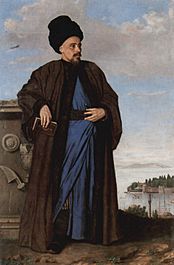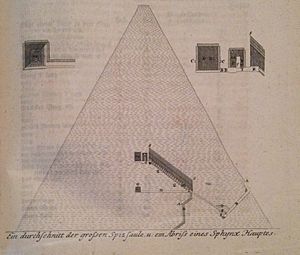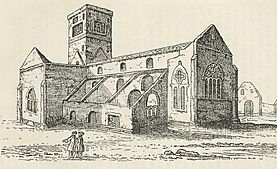Richard Pococke facts for kids
Quick facts for kids
Richard Pococke
|
|
|---|---|

Richard Pococke in Oriental Costume, 1738
— by Jean-Étienne Liotard. |
|
| Born | 19 November 1704 Southampton, England |
| Died | 25 September 1765 (aged 60) Charleville Castle, near Tullamore, Ireland |
| Nationality | English |
| Citizenship | United Kingdom of Great Britain and Ireland |
| Genre | Travel writer and diarist |
Richard Pococke (born November 19, 1704 – died September 25, 1765) was an English church leader and a famous traveler. He was known for writing about his many journeys. He served as a Bishop of Ossory (from 1756 to 1765) and later as Bishop of Meath (in 1765) in the Church of Ireland.
Contents
Richard Pococke's Life Story
Richard Pococke was born in Southampton, England. He went to Corpus Christi College, Oxford, where he studied law. His father and grandfather were also church leaders. Richard quickly became important in the church because of his family connections. He became a vicar-general for the churches in Waterford and Lismore, Ireland.
Amazing Journeys: Europe and the Middle East

Between 1733 and 1741, Richard Pococke went on two big trips, sometimes called "Grand Tours." These were long journeys across Europe. His first trip (1733–1734) took him to France and Italy. The second trip (starting in 1737) also included Italy and other European countries.
Exploring the Middle East
In 1737, Richard Pococke began a huge adventure to the Middle East. He visited many places like Egypt, Palestine, Lebanon, Syria, and Greece. He returned to England in 1742. People thought he was one of the first travelers to explore the Alps mountains.
He wrote many letters to his mother and uncle about his travels. These letters are now important records of what he saw. They include details about Venice's "Marriage to the Sea" ceremony and information about music and opera from that time.
His travels in the Middle East led to his famous books, Description of the East, published in 1743 and 1745. These books were highly praised by other writers. He also wrote about an old Arabic document called the Achtiname of Muhammad. This document claimed that the prophet Muhammad promised protection to the monks of Saint Catherine's Monastery in Egypt.
Exploring Ireland: Pococke's Tours
From 1747 to 1760, Richard Pococke traveled all around Ireland. His longest trip was in 1752, when he visited more than half of Ireland's counties. He wrote down everything he saw, but he didn't publish this travel diary himself. Years later, in 1891, his 1752 travel notes were finally published.
Discovering Scotland: Three Tours
Richard Pococke also made three trips to Scotland. The first two were short, but his third trip in 1760 was very long. He traveled as far north as the Orkney Islands.
First Scottish Tours (1747, 1750)
His first Scottish tour began on September 27, 1747, and lasted about a month. He visited cities like Edinburgh, Stirling, Glasgow, and Ayr. His second tour in 1750 was very brief, lasting only a few days. He visited Dumfries and Drumlanrig Castle.
The Big Scottish Adventure (1760)
Pococke's third tour of Scotland in 1760 lasted almost five months. He traveled all around Scotland, seeing places like Loch Lomond, Iona, Fort William, Inverness, and the Orkney Islands. He even noticed that people in Scotland ate "marmalade" (a type of fruit spread) for breakfast!
He wrote letters about his Scottish travels to his mother and sister. These letters were later put together into four books. They were published in 1887 and are still important for learning about Scotland's past.
Pococke's Church Work and Later Travels
Even though Richard Pococke loved to travel and write, he was also a very dedicated church leader. He came from a family of Anglican clergymen. His uncle, Thomas Milles, was a bishop in Ireland.
Rising in the Church
After finishing college, Richard became a priest in 1725. He spent his entire 40-year church career in the Church of Ireland, even though he was English. He was part of the Anglo-Irish social class, which meant he was an English person with an important role in Ireland.
In 1734, he became a Vicar-General. Then, in 1745, he was promoted to Archdeacon of Dublin. In 1756, he became a Bishop, serving as the Bishop of Ossory. In 1765, he became the Bishop of Meath, which was a very important position. He died just three months later.
A Preaching Bishop
Richard Pococke was known as a good preacher. During his tours in Scotland, he visited many Anglican churches. He preached and confirmed people in all of them. People respected him greatly. One newspaper wrote that he was the only Bishop of the Church of England to preach and confirm in Scotland after a big change in the church there.
He spent his later years traveling around Britain and Ireland, writing about his journeys. He passed away suddenly from a stroke in 1765 while visiting Charleville Castle in Ireland. Many of his handwritten notes and papers were given to the British Library after he died. He was buried in Ardbraccan, Ireland.
Richard Pococke's Books
- A Description of the East and Some other Countries, Vol. I: Observations on Egypt (1743)
- A Description of the East and Some other Countries, Vol. II (1745)
- Part 1: Observations on Palæstina or the Holy Land, Syria, Mesopotamia, Cyprus, and Candia.
- Part 2: Observations on the islands of the Archipelago, Asia Minor, Thrace, Greece, and some other parts of Europe.
- Tours in Scotland, 1747, 1750, 1760 (published by the Scottish History Society, 1887)
- The Travels through England of Dr. Richard Pococke, successively Bishop of Meath and of Ossory, During 1750, 1751, and Later Years (published by the Camden Society, 1888)


